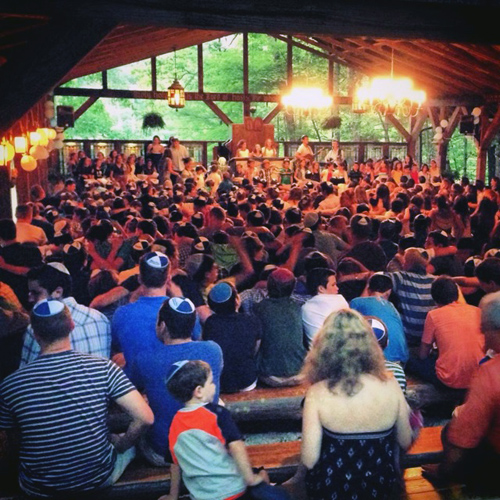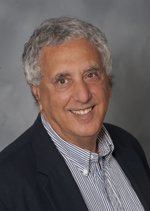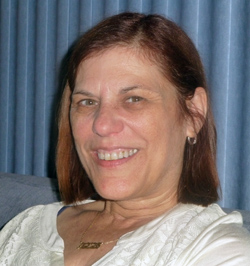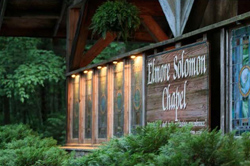
By Donald H. Harrison


SAN DIEGO — A representative of the Blue Star Camps near Hendersonville, North Carolina, says if you chat with any of the 65,000 alumni who have attended the kosher Jewish summer camp since its establishment in 1948, eventually the conversation may turn to the signature Elmore Solomon Chapel.
“The chapel was built open to the air,” commented Allison Marks, a camp staff member with a wide ranging portfolio including off-site parent contact and transportation logistics. “The benches were built from wood from the land; the stained glass windows were taken from a synagogue in Savannah that was closing… The sayings around the beams, which are built like menorahs, were submitted in the 1960s by alumni of the Blue Star Camps and they were their favorite proverbs. These sayings are around the frame of the chapel. The back of the chapel has a tile mosaic that was done by teenagers; it still is in perfect form.”
Shabbat services in the Elmore Solomon Chapel are held on both Friday nights and Saturday mornings, and they are “children-focused and children-led,” Marks said in an interview conducted during a recent visit to San Diego County to meet with prospective camper families. “Friday night is more creative and Saturday morning is a bit more traditional,” she added.
“Boys and girls participate in services together, but we don’t have a mehitza (room divider). Our camp runs on a different schedule for Shabbat. We are not shomer Shabbat (strict Sabbath observers), but we don’t go outside the camp on Shabbat, and we don’t have normal-day activities on Shabbat.
“For oneg Shabbat,” Marks added, “we have a beach party (on the shores of either of two lakes within the camp’s private acreage), and the food is like a traditional Sunday brunch–bagels and cream cheese spread, or at least such schmear as you can get in Hendersonville.”
The Torah was donated to the Elmore Solomon Chapel by trustees of a synagogue that was closing in Clarksdale, Mississippi. Previously, campers and friends of the camp had created a special tzedakah (justice and charity) fund to pay for perpetual care of a Jewish cemetery that had served the Clarksdale community.
A rabbi in Tennessee, who was a sofer, later was hired to repair the letters on the holy scroll and thereby to make it kosher. “The following summer he came in and we had a representative of each of the individual camps and members of the (Popkin) family write the last lines of the Torah,” Marks recalled. “Then we carried it in a procession around the camp, under a chuppah, and we rededicated the Torah. This is the Torah we use every Shabbos at the camp.”

Who is Elmore Solomon? If you’ve never heard of him, that was exactly the point why the chapel, a central feature of the 500-acre campgrounds, was named after him, Marks said. Elmore Solomon was quite simply a volunteer, who gladly gave of his time.
As part of his regular day, Solomon came to the camp headquarters, and volunteered to do anything that needed to be done, whether it was to run errands into Hendersonville, about seven miles from the camp, or to fix a broken door latch. When it came time to name the chapel, the camp’s owner, Herman Popkin, wanted to demonstrate to the campers that you don’t have to be famous, or donate a lot of money, to be worthy of honor from your peers, you just have to willingly and ungrudgingly do good.
A large six-pointed Memorial Board, shaped like a Magen David, on the back chapel wall reaffirms this teaching. Whether one was a camper, or a counselor, or a donor, that person’s name would be memorialized in the same type font, no bigger or smaller than anyone else’s — again to illustrate that no one is more important than anyone else in the eyes of God, or in the estimate of the Blue Star Camps.
That’s not to say that this camp is not proud of some of its famous alumni, among them the former chairman of the Federal Reserve Bank, Ben Bernanke, and Stuart Eizenstat, former chief domestic policy advisor to President Jimmy Carter. It’s just that Jewish camping isn’t about the honor you can accumulate for yourself; it is about the service that you can do for others, Marks asserted.
She said Herman Popkin’s favorite quotation from the Bible was Micah 6:8: “What does HaShem require of you but to do justice, to love kindness and to walk humbly with your God?”
Accordingly, she said, the camp teaches values befitting Micha’s admonition: “Building a sense of community, learning how to live with the world, learning to build each other’s strengths,” said Marks. “We focus a lot on tikkun olam, repairing the world, doing mitzvot.. ”
Herman Popkin and his brothers, Ben and Harry, were the original founders of the camp. Active as young men in B’nai B’rith and other Jewish organizations, all of them volunteered for military service during World War II, and as the story is told, they vowed to start a Jewish camp if the all came back safely.
Initially, the camp opened in Sautee, Georgia, but when the landowner needed the acreage for other uses, the brothers found land in western North Carolina by the Blue Ridge and Smoky Mountains. Ben died early on and eventually Harry sold his share to Herman, approximately in the 1980s. Herman continued to run the camp with his son Rodger, and today Rodger’s daughter, Lauren, is co-owner of the camp with her husband Seth Herschthal.
Allison Marks’ mother, Elly Fisher, had served as a counselor at the camp. Marks started as a 7-year-old camper, and continued at the camp as a counselor. Years later, she became involved as a camp staff member. Meanwhile her daughter, Lauren Alperstein, went through the camp, and now, it is anticipated that someday Lauren’s one-year-old son, Jonathan, will become the fourth generation of the family to attend the camp.
There are six divisions of the camp. Younger children are divided both by gender and age groups, whereas older campers join in co-educational activities, Marks said.
Marks said at camp reunions everyone will have a story about some incident that occurred during their camping life, and nearly everyone makes friends in their cohort from throughout the United States and a number of foreign countries.
She said she grew up in Miami, Florida, and her best friend, was a cabin mate from Chattanooga, Tennessee. They celebrated each other’s simchas such as weddings and children’s weddings, and have remained in close touch with each other for nearly four decades.
Marks was ten years old in 1969 when Neil Armstrong became the first man to step on the moon. She recalled that for that night, tables and chairs were cleared out of the dining hall, and boys and girls brought their sleeping bags so they could watch the small television set on the fireplace mantle as the historic event unfolded. At the time, she confessed, she didn’t appreciate the significance of the first moon walk; she was too excited about the fact that she was going to be falling asleep in a room in which there were also boys (as well as plenty of chaperoning counselors).
Her brother Seth, she said, will always remember that he had to be taken to the hospital with appendicitis and his counselor was totally distraught — not just because the camper had become seriously ill, but because that was the same day that the news flashed that Elvis Presley had died.
Blue Star Camps offer one 4-week session, or one 3-week session, or a combined 7-week session. For first-through third graders, there also are 1-week and 2-week “rookie” camp sessions. “We offer about 40 different activities for the children to choose from — mountain biking, rock climbing, pottery, drama, just about anything that a child would wish to do we pretty much offer.” Marks said.
She said there are two staffs–those that teach the specialty activities, and those that are counselors living with the children. There are two counselors per cabin.
Besides having two lakes, the camp owns its own stable of horses, with riding through the mountainous area a popular offering.
The camp is occasionally made available for under-privileged children from Hendersonville, and on other occasions, campers travel to the Boys & Girls Club in Hendersonville to participate in tikkun olam projects. From 1968-1975, and again in the 1990’s, for a period of two weeks before the summer camp opened, 200 campers from diverse ethnic backgrounds utilized the campgrounds under a program known as “Camping Unlimited.” Among the campers one year was the son of the slain Civil Rights leader, the Rev. Martin Luther King Jr., recalled Marks.
When Jewish camp started the following week, Marks’ brother, Seth, found in his locker a pair of unused underpants with the notation MLK3 written inside the band. Today, with the benefit of historic hindsight, he regrets not having kept the underwear as a souvenir. He still can say with some pride that he and Martin Luther King III (son of the Civil Rights icon) had stayed in the same cabin.
Many of the Jewish campers come from rural towns throughout the South, where there were very few Jews.
The camp was “where they gain that experience,” Marks said.
*
Harrison is editor of San Diego Jewish World. He may be contacted at donald.harrison@sdjewishworld.com
Very nice… I went to Blue Star as a camper in ’78 and for USY LTI in ’86, then covered the Torah dedication mentioned above. For the record, the community was Clarksdale, Mississippi (we went to Rosh Hashanah there a couple of years before it closed), and the rabbi/sofer was from north Alabama.
Larry, you are correct and we have corrected our story to reflect this information. Thank you!
Blue Star was the greatest place to experience nature + Judaism. I still have to get a “FIX” of mountain air to awaken my senses and bring me back to the good life experienced there.